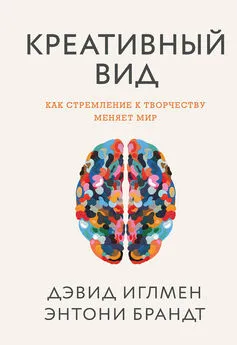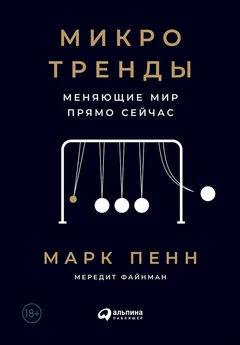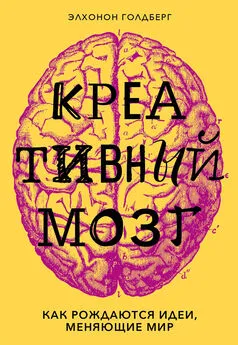Элхонон Голдберг - Креативный мозг [Как рождаются идеи, меняющие мир] [litres]
- Название:Креативный мозг [Как рождаются идеи, меняющие мир] [litres]
- Автор:
- Жанр:
- Издательство:Литагент 5 редакция «БОМБОРА»
- Год:2019
- Город:Москва
- ISBN:978-5-04-105057-3
- Рейтинг:
- Избранное:Добавить в избранное
-
Отзывы:
-
Ваша оценка:
Элхонон Голдберг - Креативный мозг [Как рождаются идеи, меняющие мир] [litres] краткое содержание
Какова природа творчества? Какая работа разума скрывается за его мистикой? Каковы эволюционные корни креативности? В книге нейробиолога и нейропсихолога Элхонона Голдберга эти и другие вопросы рассматриваются как с научной, так с исторической и культурологической точек зрения, превращаясь в масштабное и увлекательное исследование. Опираясь на результаты последних открытий и исследований мозга, а также на собственные идеи и гипотезы, Голдберг приходит к оригинальному, убедительному и даже провокационному пониманию природы творчества и креативности. Читатель совершит удивительное путешествие сквозь эпохи и страны: от античности до далекого будущего, от Западной Европы до Юго-Восточной Азии. Автор делает смелые прогнозы о перспективных направлениях творчества и инноваций, объясняя их биологические и культурные истоки, рассказывает о том, как они сформируют общество будущего и изменят способы развития человеческого мозга.
Креативный мозг [Как рождаются идеи, меняющие мир] [litres] - читать онлайн бесплатно ознакомительный отрывок
Интервал:
Закладка:
8. D. Wang, R. L. Buckner, and X. H. Liu, «Functional Specialization in the Human Brain Estimated by Intrinsic Hemispheric Interaction», The Journal of Neuroscience 34 (2014): 12341—12352.
9. D. Sridharan, D. J. Levitin, and V. Menon, «A Critical Role for the Right Frontoinsular Cortex in Switching Between Central-Executive and Default-Mode Networks», Proceedings of the National Academy of Sciences 105 (2008): 12569—12574; D. Sridharan, D. J. Levitin, C. H. Chafe, J. Berger, and V. Menon, «Neural Dynamics of Event Segmentation in Music: Converging Evidence for Dissociable Ventral and Dorsal Networks», Neuron 55 (2007): 521–532.
10. T. T. Chong, R. Cunnington, M. A. Williams, and J. B. Mattingley, «The Role of Selective Attention in Matching Observed and Executed Actions», Neuropsychologia 47 (2009): 786–795; T. T. Chong, R. Cunnington, M. A. Williams, N. Kanwisher, and J. B. Mattingley, «fMRI Adaptation Reveals Mirror Neurons in Human Inferior Parietal Cortex», Current Biology 18 (2008): 1576–1580.
11. H. P. Op de Beeck, C. I. Baker, J. J. DiCarlo, and N. G. Kanwisher, «Discrimination Training Alters Object Representations in Human Extrastriate Cortex», The Journal of Neuroscience 26 (2006): 13025—13036.
12. M. Delazer, F. Domahs, L. Bartha, C. Brenneis, A. Lochy, T. Trieb, and T. Benke, «Learning Complex Arithmetic— An FMRI Study», Brain Research: Cognitive Brain Research 18 (2003): 76–88.
13. D. Sridharan, D. J. Levitin, and V. Menon», A Critical Role for the Right Fronto-insular Cortex in Switching Between Central-Executive and Default-Mode Networks», Proceedings of the National Academy of Sciences 105 (2008): 12569—12574.
14. S. J. Sara, C. Dyon-Laurent, and A. Hervé, «Novelty Seeking Behavior in the Rat Is Dependent upon the Integrity of the Noradrenergic System», Brain Research: Cognitive Brain Research 2 (1995): 181–187.
15. C. Lee, J. W. Yang, S. H. Lee, S. H. Kim, S. H. Joe, I. K. Jung, I. G. Choi, and B. J. Ham, «An Interaction Between the Norepinephrine Transporter and Monoamine Oxidase A Polymorphisms, and Novelty-seeking Personality Traits in Korean Females», Progress in Neuro-Psychopharmacology and Biological Psychiatry 32 (2008): 238–242.
16. R. R. I. Kruglikov, N. V. Orlova, and V. M. Getsova, «Content of Norepinephrine and Serotonin in Symmetrical Divisions of the Brain of Rats in the Norm During Learning and with the Administration of Peptides», Neuroscience and Behavioral Physiology 22 (1992): 128–131; S. D. Glick, D. A. Ross, and L. B. Hough, «Lateral Asymmetry of Neurotransmitters in Human Brain», Brain Research 234 (1982): 53–63; R. Carter, Mapping the Mind (London, UK: Phoenix Publishing, 2004); S. D. Glick, Cerebral Lateralization in Non-Human Species (Cambridge, MA: Academic Press, 1985); S. D. Glick, R. C. Meibach, R. D. Cox, and S. Maayani, «Multiple and Interrelated Functional Asymmetries in Rat Brain», Life Sciences 25 (1979): 395–400.
17. S. Grossberg, Neural Networks and Natural Intelligence (Cambridge, MA: MIT Press, 1988); R. C. O’Reilly and Y. Munakata, Computational Explorations in Cognitive Neuroscience (Cambridge, MA: MIT Press, 2000).
18. Y. Hakeem, C. C. Sherwood, C. J. Bonar, C. Butti, P. R. Hof and J. M. Allman, «Von Economo Neurons in the Elephant Brain», The Anatomical Record 292 (2009): 242–248.
19. J. M. Allman, N. A. Tetreault, A. Y. Hakeem, K. F. Manaye, K. Semendeferi, J. M. Erwin, S. Park, V. Goubert, and P. R. Hof, «The Von Economo Neurons in the Frontoinsular and Anterior Cingulate Cortex», Annals of the New York Academy of Sciences 1225 (2011): 59–71.
20. P. Rourke, Nonverbal Learning Disabilities: The Syndrome and the Model, 1st edn. (New York: The Guilford Press, 1989).
21. A. Kluger and E. Goldberg, «Comparison of VIQ/ PIQ Ratios in Patients with Affective Disorders, Diffuse and Right Hemisphere Brain Disease», Journal of Clinical and Experimental Neuropsychology 12 (1990): 182–194.
22. C. Chiron, I. Jambaque, R. Nabbout, R. Lounes, A. Syrota and O. Dulac, «The Right Brain Hemisphere Is Dominant in Human Infants», Brain 120 (1997): 1057–1065.
23. E. Goldberg, The Wisdom Paradox: How Your Mind Can Grow Stronger as Your Brain Grows Older (New York: Gotham Books, 2005).
24. V. Llaurens, M. Raymond, and C. Faurie, «Why Are Some People Left-handed? An Evolutionary Perspective», Philosophical Transactions of the Royal Society of London, B: Biological Sciences 364 (2009): 881–894.
25. H. I. Kushner, «Why Are There (Almost) No Left-handers in China?» Endeavour 37 (2013): 71–81.
26. S. Wang and S. Aamodt, «A Vast Left-handed Conspiracy», The Washington Post (July 6, 2008): http:// www.washingtonpost.com/ wp-dyn/ content/ article/ 2008/07/ 03/ AR2008070303202.html
27. J. Goodman, «The Wages of Sinistrality: Handedness, Brain Structure, and Human Capital Accumulation», Journal of Economic Perspectives 28 (2014): 193–212; C. S. Ruebeck, J. E. Harrington, Jr., and R. Moffitt, «Handedness and Earnings», Laterality: Asymmetries of Brain Body and Cognition 12 (2007): 101–120.
28. Goldberg, K. Podell, R. Harner, M. Lovell, and S. Riggio, «Cognitive Bias, Functional Cortical Geometry, and the Frontal Lobes: Laterality, Sex, and Handedness», Journal of Cognitive Neuroscience 6 (1994): 274–294.
29. R. Kumar and A. E. Lang, «Coexistence of Tics and Parkinsonism: Evidence for Non-dopaminergic Mechanisms in Tic Pathogenesis», Neurology 49 (1997): 1699–1701.
30. Goldberg, K. Podell, R. Harner, M. Lovell, and S. Riggio, «Cognitive Bias, Functional Cortical Geometry, and the Frontal Lobes: Laterality, Sex, and Handedness», Journal of Cognitive Neuroscience 6 (1994): 274–294; K. Podell, «When East Meets West: Systematizing Luria’s Approach to Executive Control Assessment», in Luria’s Legacy in the 21st Century, Eds. A. L. Christensen, E. Goldberg, and D. Bougakov (New York: Oxford University Press, 2009): 122–145.
31. S. Varanese, B. Perfetti, S. Mason, A. Di Rocco, and E. Goldberg, «Lateralized Profiles of Frontal Lobe Dysfunction in Parkinson’s Disease», Presented at the Seventh International Congress on Mental Dysfunctions and Other Nonmotor Features in Parkinson’s Disease and Related Disorders (Barcelona, Spain: December 9—12, 2010)
32. D. M. Sheppard, J. L. Bradshaw, R. Purcell, and C. Pantelis, «Tourette’s and Comorbid Syndromes: Obsessive Compulsive and Attention Deficit Hyperactivity Disorder. A Common Etiology?» Clinical Psychology Review 19 (1999): 531–552; R. Rizzom, M. Gulisano, P. V. Cali, and P. Curatolo, «Tourette Syndrome and Comorbid ADHD: Current Pharmacological Treatment Options», European Journal of Paediatric Neurology 17 (2013): 421–428; M. Bloch, M. State, and C. Pittenger, «Recent Advances in Tourette Syndrome», Current Opinion in Neurology 24 (2011): 119–125; R. H. Bitsko, J. R. Holbrook, S. N. Visser, J. W. Mink, S. H. Zinner, R. M. Ghandour, and S. J. Blumberg, «A National Profile of Tourette Syndrome, 2011–2012», Journal of Developmental & Behavioral Pediatrics 35 (2014): 317–322; «Tourette Syndrome: Data and Statistics», Centers for Disease Control (2016): http:// www.cdc.gov/ ncbddd/ tourette/ data.html.
33. O. W. Sacks, «Tourette’s Syndrome and Creativity», British Medical Journal 305 (1992): 1515–1516.
34. E. Goldberg, «ADHD, Tourette’s and the Fallacy of Fads», Keynote address at International Conference on Neuroethics (ICONE) (Lisbon, Portugal, April 9—10, 2015).
35. F. Lhermitte, B. Pillon, and M. Serdaru, «Human Autonomy and the Frontal Lobes. Part I: Imitation and Utilization Behavior: A Neuropsychological Study of 75 Patients», Annals of Neurology 19 (1986): 326–334; E. Goldberg and L. Costa, «Qualitative Indices in Neuropsychological Assessment: Extension of Luria’s Approach. Executive Deficit Following Prefrontal Lesions», in Neuropsychological Assessment in Neuropsychiatric Disorders, Eds. K. Adams and I. Grant (New York: Oxford University Press, 2009): 48–64; E. Goldberg, The New Executive Brain: Frontal Lobes in a Complex World (New York: Oxford University Press, 2009).
36. Теперь этого провала нет благодаря моим бывшим студентам и коллегам Энди Лопес-Уильямсу и Шелл Хувик, которые разработали шкалу исследовательского поведения и недавно усовершенствовали ее.
37. E. Goldberg, The New Executive Brain: Frontal Lobes in a Complex World (New York: Oxford University Press, 2009).
38. K. T. Hovik, M. Øie, and E. Goldberg, «Inside the Triple-Decker: Tourette’s Syndrome and Cerebral Hemispheres», Executive Functions in Health and Disease, Ed. E. Goldberg (Cambridge, MA: Academic Press, 2017).
39. R. H. Bitsko, J. R. Holbrook, S. N. Visser, J. W. Mink, S. H. Zinner, R. M. Ghandour, and S. J. Blumberg, «A National Profile of Tourette Syndrome, 2011–2012», Journal of Developmental & Behavioral Pediatrics 35 (2014): 317–322.
40. E. Goldberg, K. Podell, R. Harner, M. Lovell, and S. Riggio, «Cognitive Bias, Functional Cortical Geometry, and the Frontal Lobes: Laterality, Sex, and Handedness», Journal of Cognitive Neuroscience 6 (1994): 274–294.
41. S. C. Cohen, J. M. Mulqueen, E. Ferracioli-Oda, Z. D. Stuckelman, C. G. Coughlin, J. F. Leckman, and M. H. Bloch, «Meta-Analysis: Risk of Tics Associated with Psychostimulant Use in Randomized, Placebo-Controlled Trials», Journal of the American Academy of Child and Adolescent Psychiatry 54 (2015): 728–736.
1. B. Ghiselin, The Creative Process: Reflections on the Invention in the Arts and Sciences, 1st edn. (Oakland, CA: University of California Press, 1985).
2. D. T. Campbell, «Blind Variation and Selective Retentions in Creative Thought as in Other Knowledge Processes», Psychological Review, 67 (1960): 380–400; R. E. Jung, B. S. Mead, J. Carrasco, and R. A. Flores, «The Structure of Creative Cognition in the Human Brain», Frontiers in Human Neuroscience 7 (2013): 330.
3. H. A. Simon, The Sciences of the Artificial, 3rd edn. (Cambridge, MA: MIT Press, 1996): 194.
4. A. Dietrich, «Transient Hypofrontality as a Mechanism for the Psychological Effects of Exercise», Psychiatry Research 145 (2006): 79–83.
5. Видеозапись танца «Sanghyang Jaran» сделана сыном моего балинезийского друга Ида Багус Йоги Исвара Бава, которого я попросил сопровождать меня: https:// youtu.be/ g_ nAGNrLjiM. Более подробное обсуждение временной гипофронтальности в измененных состояниях сознания можно найти здесь: A. Dietrich, «Functional Neuroanatomy of Altered States of Consciousness: The Transient Hypofrontality Hypothesis», Consciousness and Cognition 12 (2003): 231–256.
6. M. L. Grillon, C. Oppenheim, G. Varoquaux, F. Charbonneau, A. D. Devauchelle, M. O. Krebs, F. Baylé, B. Thirion, and C. Huron, «Hyperfrontality and Hypoconnectivity During Refreshing in Schizophrenia», Psychiatry Research 211 (2013): 226–233.
7. A. Hampshire, A. Macdonald, and A. M. Owen, «Hypoconnectivity and Hyperfrontality in Retired American Football Players», Scientific Reports 3 (2013): 2972.
8. F. X. Vollenweider, K. L. Leenders, C. Scharfetter, P. Maguire, O. Stadelmann, and J. Angst, «Positron Emission Tomography and Fluorodeoxyglucose Studies of Metabolic Hyperfrontality and Psychopathology in the Psilocybin Model of Psychosis», Neuropsychopharmacology 16 (1997): 357–372; C. Dackis and C. O’Brien, «Neurobiology of Addiction: Treatment and Public Policy Ramifications», Nature Neuroscience 8 (2005): 1431–1436.
Читать дальшеИнтервал:
Закладка:
![Обложка книги Элхонон Голдберг - Креативный мозг [Как рождаются идеи, меняющие мир] [litres]](/books/1065923/elhonon-goldberg-kreativnyj-mozg-kak-rozhdayutsya-id.webp)









